Biography of Duke Ellington: Jazz Legend’s Life and Legacy
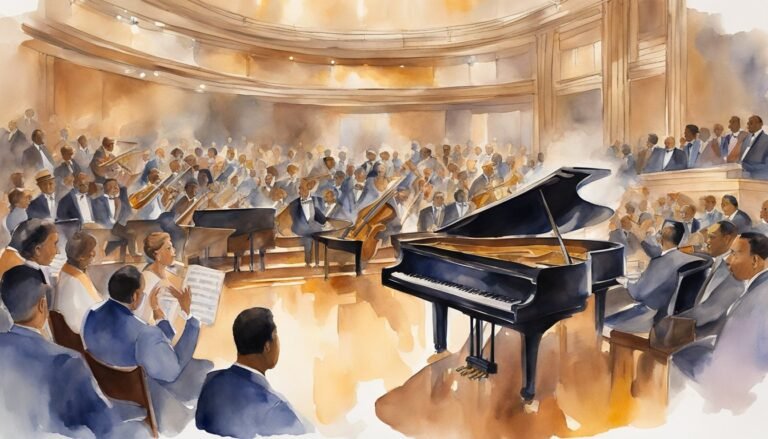
Edward Kennedy “Duke” Ellington was one of the greatest jazz composers and bandleaders of the 20th century.
Born in Washington, D.C., Ellington rose to fame in the late 1920s, performing at the Cotton Club in Harlem. Ellington composed thousands of pieces that showcased his unique style and innovation in jazz.
His impact on music spans over 50 years, leaving a legacy that still resonates today.
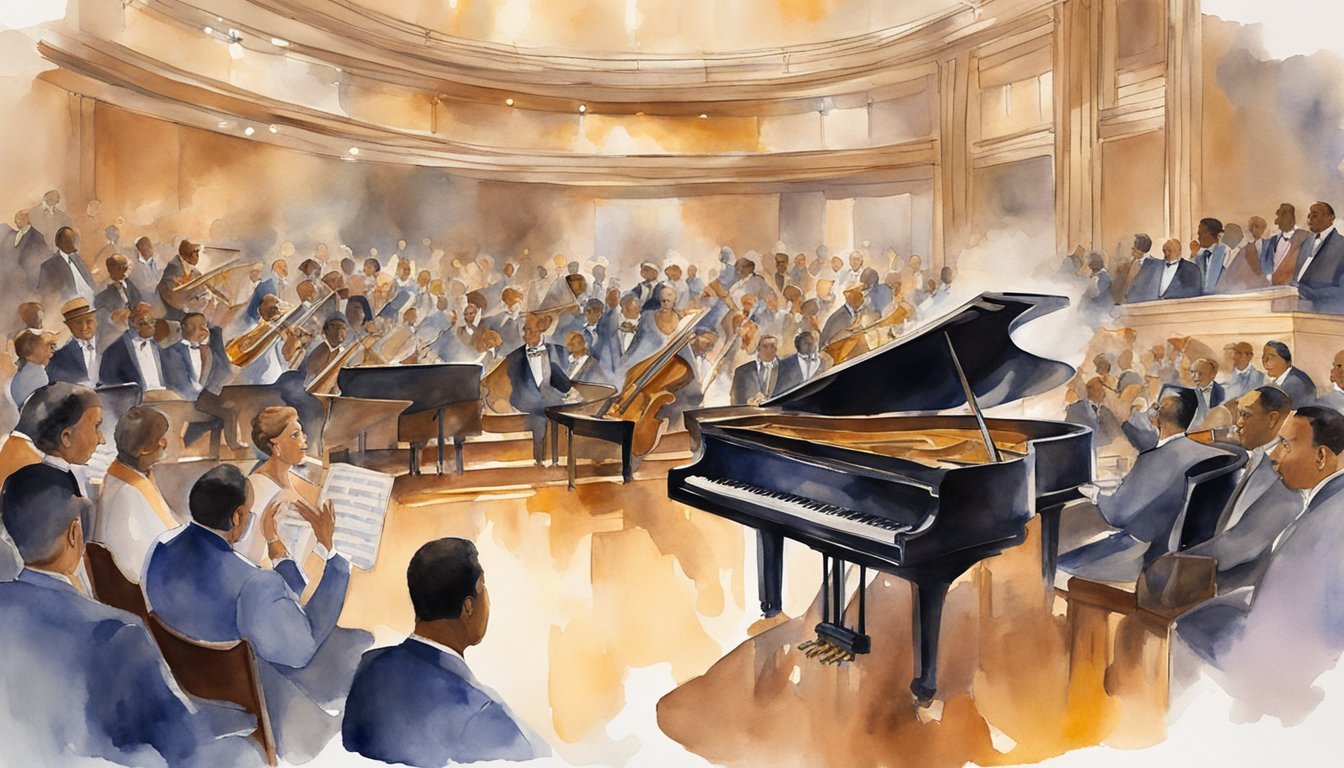
Ellington’s journey to stardom was shaped by his early life and education, which instilled in him a deep passion for music.
By leading his own jazz orchestra, Ellington transformed jazz into an art form that included complex structures and melodies.
He also worked with many notable musicians, creating a sound that was distinctively his own.
Despite the challenges he faced, Ellington’s dedication to his craft never wavered.
He received numerous awards and honors, solidifying his place as an influential figure in music history.
His contributions go beyond jazz, as he has left an indelible impact on art and culture worldwide.
For those interested in delving into the secret spiritual knowledge behind his genius, you might find this link interesting.
Key Takeaways
- Duke Ellington was a pioneering jazz composer and bandleader.
- His career spanned over 50 years with numerous collaborations and hit songs.
- Ellington’s legacy continues to influence art and culture globally.
Early Life and Education
Duke Ellington, born as Edward Kennedy, had a profound impact on jazz music.
Growing up in Washington, D.C., his early exposure to music played a crucial role in shaping his legendary career.
Washington, D.C. Roots
Edward Kennedy Ellington, widely known as Duke Ellington, was born on April 29, 1899, in Washington, D.C. His parents, James Edward and Daisy Ellington, were both musically inclined, which greatly influenced his early life.
Ellington grew up in a middle-class neighborhood, surrounded by a supportive and culturally rich community.
His father worked as a butler, providing young Duke with early exposure to the sophistication and elegance he would later incorporate into his music.
Washington, D.C., known for its vibrant culture and diversity, offered him numerous opportunities to experience different musical styles.
This environment nurtured his early interest in music and set the stage for his future success.
Musical Beginnings
By the age of seven, Ellington began piano lessons, encouraged by his mother. 🎵 He quickly developed a love for the instrument and, inspired by ragtime music, started composing his own melodies.
His talent was evident early on, and he gained a reputation as a gifted pianist among his peers.
In high school, Ellington’s passion for music grew.
He played professionally at local venues and began to attract a following.
His dedication to the piano and his innovative approach to composition made him stand out.
Seeking to broaden his horizons, he moved to New York City in the 1920s.
Here, he formed his own band and became a key figure in the Harlem Renaissance.
Learn more about his journey and secret spiritual knowledge here.
Ellington’s early experiences in Washington, D.C., combined with his formal and informal education in music, laid the foundation for his illustrious career. 🎹
Rise to Fame
Duke Ellington’s journey to stardom was marked by his innovative work at Harlem’s Cotton Club and his distinct musical style.
He created iconic pieces like “Sophisticated Lady” and “Mood Indigo” that solidified his reputation.
The Cotton Club Era
In the late 1920s, Ellington’s career took off 🚀 when his band started performing at the Cotton Club in Harlem.
The club was a popular and prestigious venue, which played a significant role in his rise to fame.
Here, Ellington composed and arranged music that captivated audiences.
His shows featured a blend of music and dance routines, making the performances lively and entertaining.
Ellington’s style mixed traditional jazz with his own unique flair, which helped him stand out.
This era produced classics like “Mood Indigo,” echoing the sophisticated atmosphere of the club.
Creating a Unique Sound
Ellington was known for creating a distinctive sound that set him apart from other musicians.
He experimented with complex harmonies and orchestrations that gave his music a smooth, elegant feel.
Using the talents of his orchestra, he crafted pieces with rich textures and emotional depth.
Songs like “Sophisticated Lady” showcased his ability to blend different musical elements seamlessly.
Ellington’s collaborations with other musicians also contributed to his unique sound.
His ability to innovate and push musical boundaries earned him acclaim and lasting fame.
Check out his secret to harnessing spiritual knowledge here 🌟.
Musical Style and Innovations
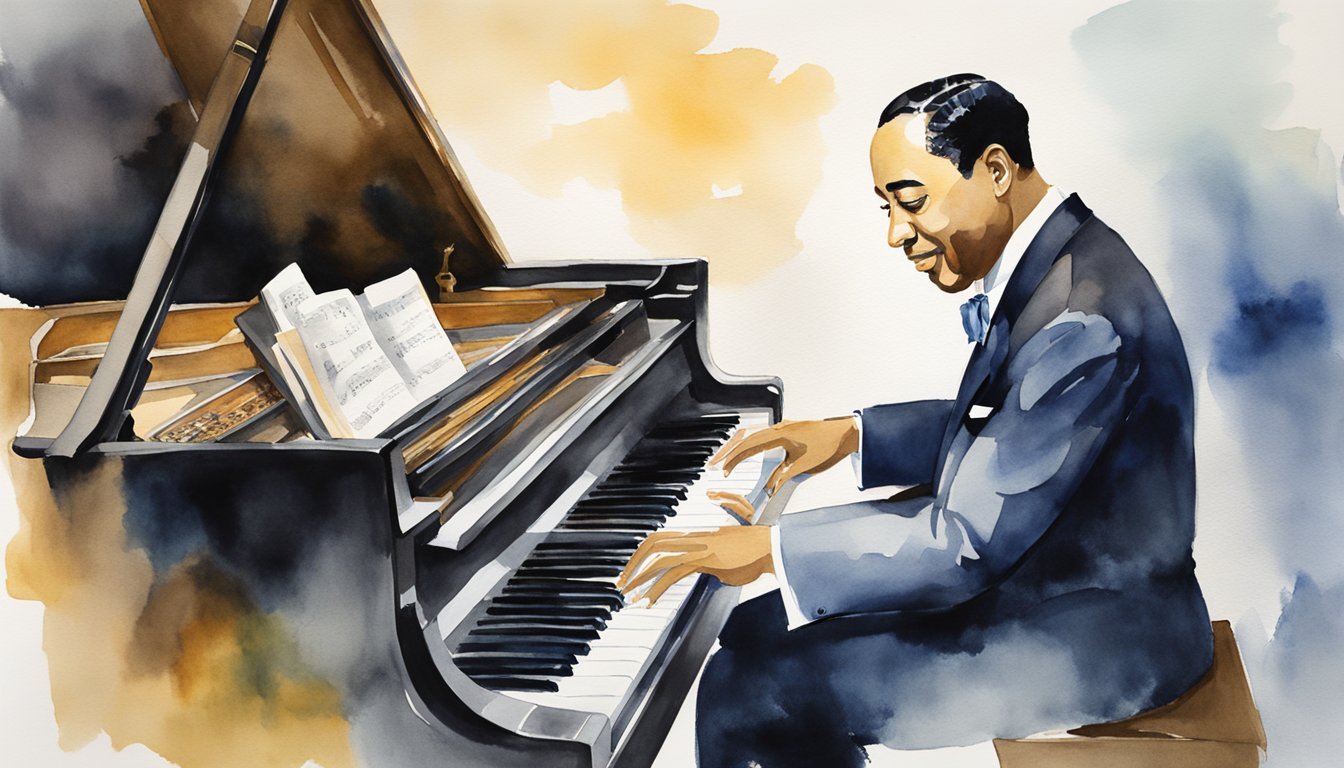
Duke Ellington was a pioneer in the jazz world, bringing a unique twist to traditional genres and revolutionizing how orchestras operated.
Blending Genres
Ellington was known for his ability to combine different musical styles.
He mixed elements of classical music, blues, and jazz to create something new.
One of his famous compositions, “Mood Indigo,” shows this mix with its haunting melodies and rich harmonies.
He often used unusual instruments in jazz, like the bass clarinet and French horn, which gave his pieces a distinctive sound.
This willingness to experiment made his music stand out.
Ellington’s and his orchestra’s performances at the Cotton Club were legendary, showcasing his talent for fusing genres.
These shows had a huge influence on American music, and they remain iconic in jazz history.
His ability to blend styles is one reason he is considered a great composer and musician.
Banding Techniques
Ellington developed innovative techniques for his orchestra.
He allowed each musician to showcase their individual talents, resulting in a more dynamic and varied performance.
This method of highlighting soloists became a signature of Ellington’s style.
One of his well-known techniques was “voicing across sections,” where different sections of the orchestra would play parts of the same melody.
This created a rich, layered sound that was unique to Ellington’s band.
His approach inspired many other bandleaders at the time.
Another innovation was his use of “jungle sounds.” Using growling brass and exotic rhythms gave his music an earthy, primal feel.
Ellington’s ability to innovate and elevate his musicians helped redefine what an orchestra could be, making him a key figure in jazz history.
Discover more about secret spiritual knowledge 🔍
Notable Collaborations
Duke Ellington’s collaborations produced some of the most memorable jazz music.
His work with Billy Strayhorn and other jazz legends like Cootie Williams and Johnny Hodges contributed significantly to his legacy.
Billy Strayhorn Partnership
Billy Strayhorn was not just a partner but a key contributor to Ellington’s sound.
They worked together for almost three decades, creating classics like “Take the ‘A’ Train.” Strayhorn’s influence is evident in many of Ellington’s works.
Strayhorn joined Ellington in 1939 and quickly became indispensable.
He had a knack for crafting sophisticated arrangements.
Ellington trusted him completely, often referring to Strayhorn as his “alter ego.”
Their collaboration wasn’t limited to composing.
On stage, Strayhorn’s role was significant too.
The duo’s seamless teamwork produced timeless pieces that still resonate with jazz lovers today.
Working with Jazz Greats
Ellington’s orchestra boasted talents like Cootie Williams and Johnny Hodges.
Cootie Williams’ trumpet was a crucial part of the band.
His style added a unique flair to many performances.
Johnny Hodges, the saxophonist, brought a soulful voice to Ellington’s music.
His smooth playing was especially notable in tunes like “Isfahan.” Both musicians’ contributions elevated Ellington’s compositions.
Collaborating with these jazz greats, Ellington created a sound that was unmatched.
Each member’s unique style blended perfectly, resulting in a rich, dynamic sound.
These collaborations were a testament to Ellington’s ability to bring out the best in every musician he worked with.
For those curious about more mystical aspects of Ellington’s world, like secret spiritual knowledge, check this link. 🎷🎶
Masterpieces and Hit Songs
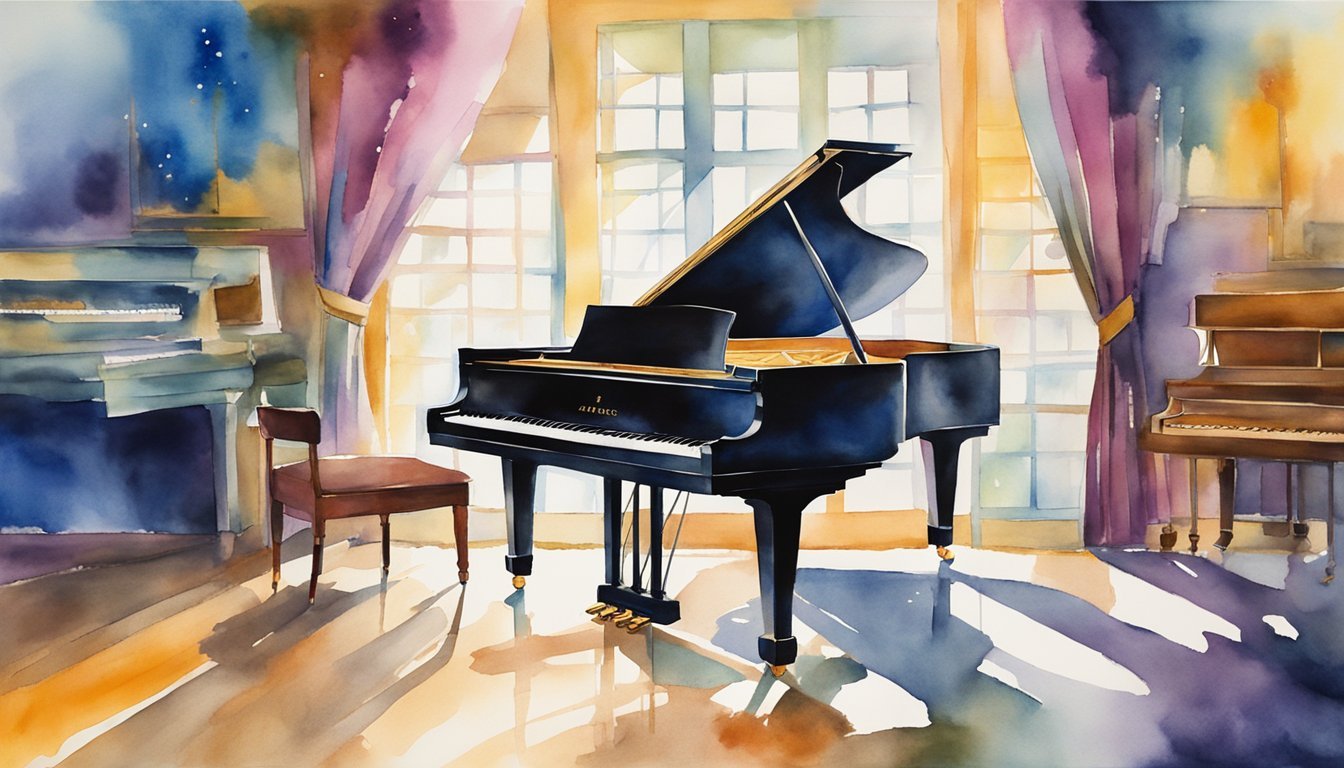
Duke Ellington was a powerhouse in jazz, creating numerous hit songs and landmark albums that have stood the test of time.
His works are celebrated for their innovation and impact on the jazz scene.
Iconic Albums and Tracks
Ellington created many albums that left a lasting impression in the music world.
A standout album is “Duke Ellington & John Coltrane”.
This collaboration brought together two legends of jazz, resulting in timeless tracks that are still celebrated today.
“Money Jungle” is another essential Ellington album.
Recorded with Charles Mingus and Max Roach, it’s noted for its intense, complex compositions.
Among his hit tracks, “In a Sentimental Mood” stands out for its emotional depth and beauty. “Cotton Tail” is another significant track known for its lively, swinging style, showcasing Ellington’s prowess in big-band jazz.
His piece “Solitude” remains a classic, beloved for its haunting melody and rich orchestration 🎶.
Soundtrack and Stage Contributions
Ellington’s talents extended beyond albums and singles, impacting both film and stage.
He composed scores for movies like “Anatomy of a Murder”.
This film score was remarkable for its ability to blend jazz with cinematic storytelling.
On the stage, Ellington made significant contributions to musicals such as “Jump for Joy” and “Beggar’s Holiday”.
These works were groundbreaking in combining jazz with theater, bringing a new flair to Broadway.
His suite “Black, Brown and Beige” is another major work.
It debuted at Carnegie Hall and is a powerful narrative through music.
By exploring themes both modern and spiritual, Ellington’s contributions go beyond entertainment, delving into secret spiritual knowledge and bringing profound insights to the listener.
Global Influence and Tours
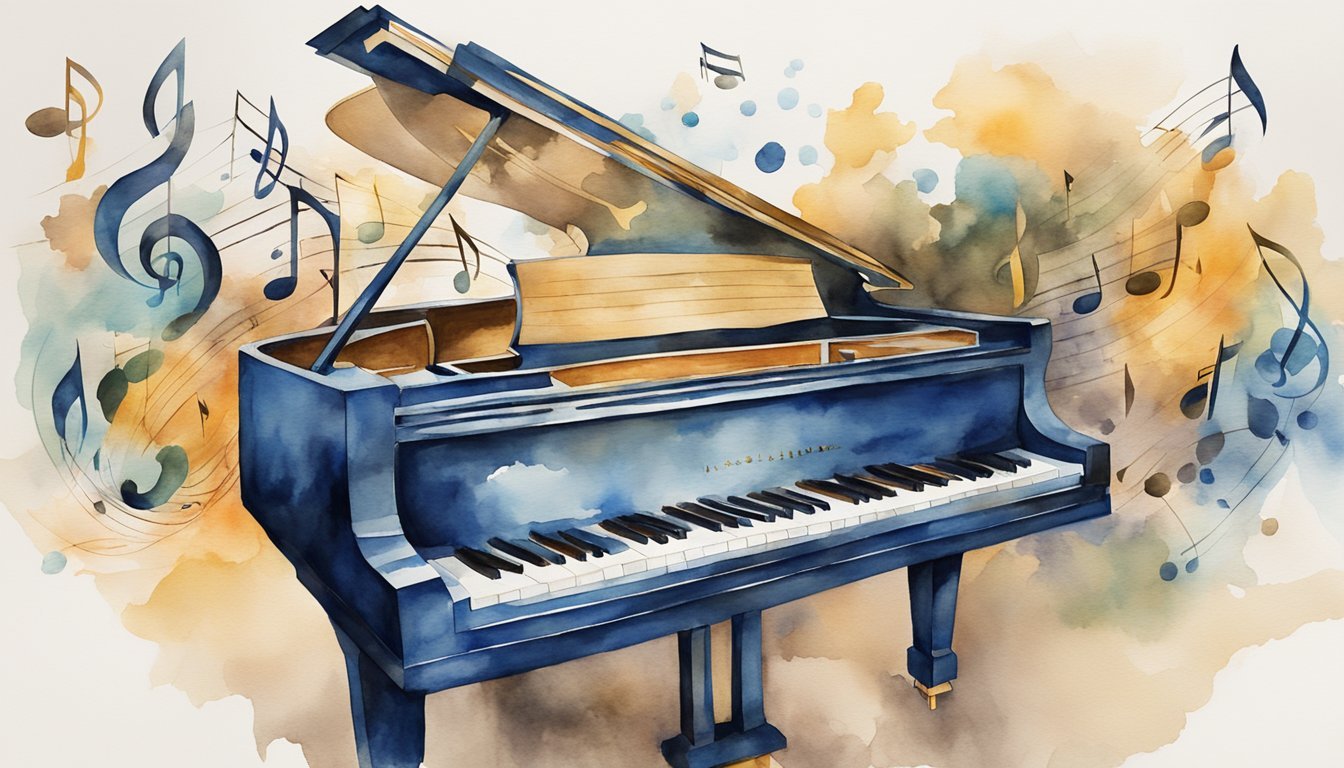
Duke Ellington’s music reached far beyond the United States, gaining appreciation and respect from audiences around the globe.
This section delves into how European listeners received his work and how Ellington’s tours brought his unique sound to international stages.
European Reception
Duke Ellington’s first tour of Europe in 1933 was a major success.
Jazz was already popular in many European cities, but Ellington’s sophisticated compositions and unique style captivated audiences.
He played in cities like Paris, London, and Stockholm, leaving a lasting impact on the European jazz scene. 🎷
European critics and fans alike praised his work.
His use of complex harmonies and rhythms set him apart from other jazz musicians.
During the 1930s and 1940s, Europe became a crucial market for his recordings.
The enthusiasm of European audiences helped to cement his reputation as a leading figure in American music.
Ellington’s World Tours
Starting in the 1950s, Duke Ellington began to tour extensively outside of Europe.
He and his orchestra played in Latin America, Asia, and the Middle East.
In 1963, Ellington even performed in the Soviet Union, which was a groundbreaking event during the Cold War. 🌍
These tours introduced new audiences to jazz, helping to spread American music globally.
Ellington’s performances were often met with great enthusiasm, and he became a cultural ambassador for the United States.
His world tours enriched his music, blending different cultural influences into his work.
Want to delve deeper into secret spiritual knowledge? Check out this link! 🕉️
Ellington’s Band and Musicians
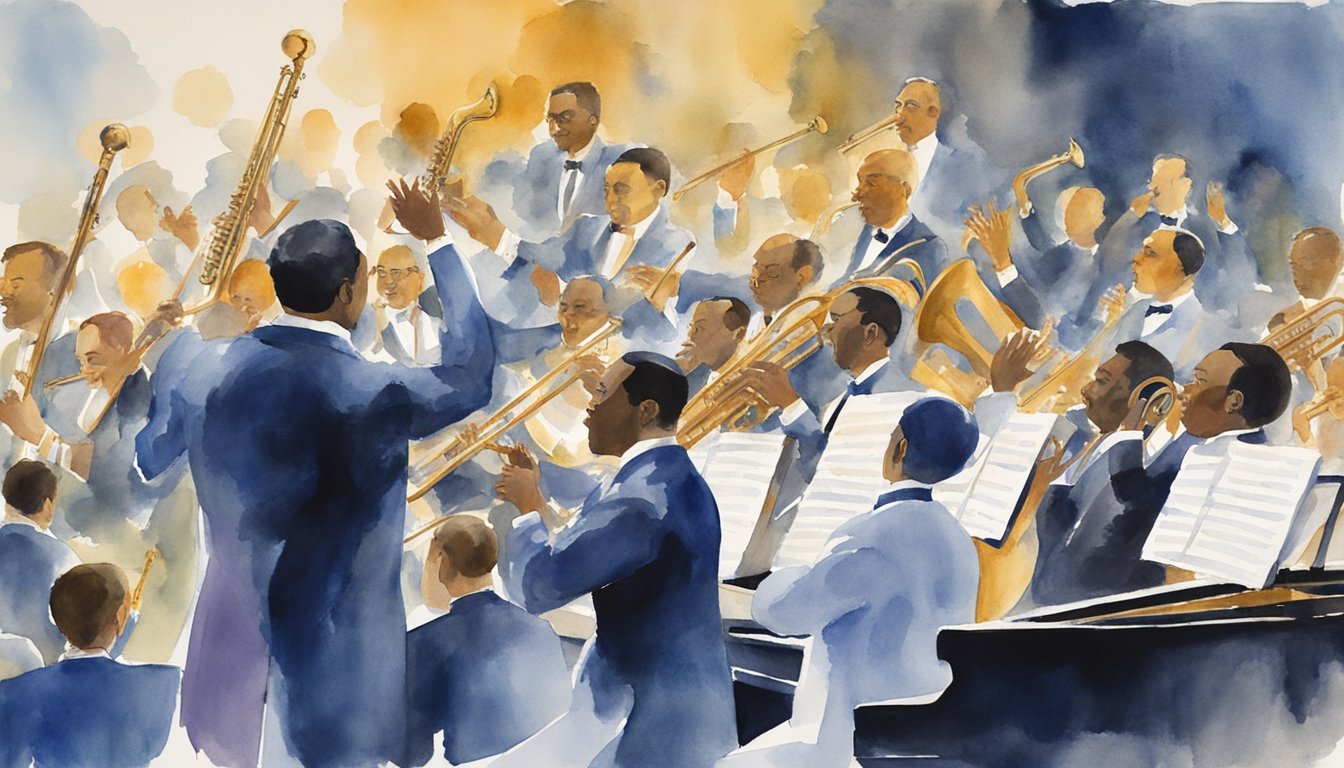
Duke Ellington’s orchestra was a key platform for many legendary musicians.
His band was known for its unique sound and showcased some of the most talented artists of the jazz era.
Noteworthy Band Members
Ellington’s band featured several standout musicians. Cootie Williams, with his powerful trumpet performances, became a defining part of the band’s sound.
He had a knack for creating melodies that resonated deeply with audiences. 😊
Another remarkable member was Johnny Hodges, the alto saxophonist whose smooth playing style became one of the band’s signatures.
His emotive performances added a soulful touch to their music. 🍀
Jimmy Blanton was another significant figure.
As a bassist, his innovative techniques brought new dimensions to the band’s rhythm section.
He was instrumental in making the bass a prominent voice in jazz.
Talent Recruitment and Legacy
Ellington had an exceptional eye for talent, drawing in musicians who could bring something fresh to the table.
He looked for individualism, skill, and the ability to adapt to the band’s dynamic style.
His approach to recruitment helped establish a legacy where the orchestra was more than just a band 🎺.
It was a breeding ground for future jazz legends.
Many of these musicians went on to have successful solo careers.
Learning about the secret skills behind his remarkable team can give you a deeper appreciation for their work.
Discover more about the secret spiritual knowledge that might have fueled their creativity.
Challenges and Triumphs

Throughout his career, Duke Ellington faced numerous challenges ranging from racial barriers to public criticism.
Yet, his remarkable talent and resilience allowed him to triumph and leave a lasting impact on jazz and American culture.
Overcoming Racial Barriers
Duke Ellington’s career began during a time when racial segregation was prevalent in America.
As an African-American, he encountered significant obstacles.
For instance, in 1936, Duke’s orchestra became the first Black ensemble to perform at the University of Texas in Austin, breaking racial barriers in the music industry.
Ellington used his influence to subvert racist stereotypes.
He consciously crafted a sophisticated image, wearing stylish suits and performing with elegance.
This approach not only defied stereotypes but also attracted a diverse audience.
Moreover, Ellington’s music, like his piece Black and Tan Fantasy, highlighted the richness of Black culture.
By doing so, he gained acclaim and disrupted the status quo, contributing to the broader Civil Rights movement.
He leveraged his art to promote equality and social justice, becoming a symbol of African-American strength and ingenuity. 🎵
Criticism and Acclaim
Throughout his career, Duke Ellington received both criticism and acclaim.
Some critics initially doubted his innovative style, considering it too complex or unconventional.
Others could not see past racial prejudices to appreciate his genius fully.
Despite the criticism, many admired Ellington’s talent.
He gained praise from fellow musicians, like Nat “King” Cole, who stated that “Duke will always be 25 years ahead” (read more).
His unique compositions and performances, such as his work with “Mood Indigo” and “Sophisticated Lady,” garnered widespread acclaim.
Ultimately, Ellington’s legacy as one of the greatest Jazz composers and bandleaders was cemented by his ability to transform critique into motivation.
His resilience and ability to innovate continually secured his place in music history.
He faced judgment but ultimately triumphed, leaving an indelible mark on the world of jazz.
🔍 For more insights into spiritual aspects that influenced Duke Ellington, you can explore secret spiritual knowledge.
Personal Life and Legacy
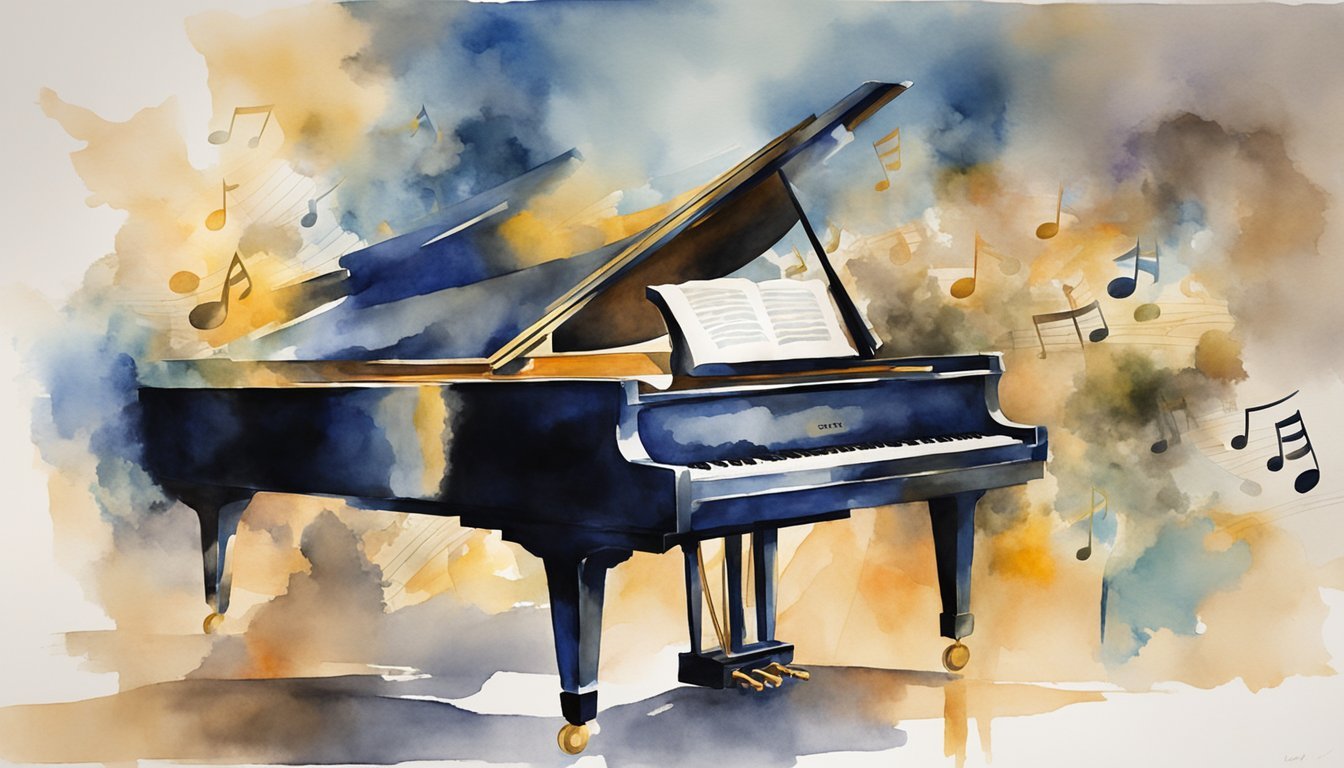
Duke Ellington, born Edward Kennedy Ellington, had a rich personal life and left a lasting legacy.
He was admired not only for his musical talent but also for his deep family values and the recognition he received after his death.
Family and Personal Relationships
Ellington was married to his high school sweetheart, Edna Thompson, on July 2, 1918.
The couple had one son, Mercer Ellington, who later became a notable musician and joined his father’s band.
His family played a significant role in his life, providing support throughout his career.
Though Ellington had a busy life on the road, he maintained close ties with his family.
He valued these relationships, which fueled his creative work.
He was known for his charming personality and the friendships he cultivated within the music industry.
Death and Posthumous Recognition
Duke Ellington passed away on May 24, 1974, in New York City.
He was laid to rest at Woodlawn Cemetery, a place that houses many famous individuals.
After his death, his immense contributions to music were recognized with numerous awards.
One of the highest honors was the Presidential Medal of Freedom, awarded posthumously in recognition of his vast impact on American culture and music.
For those interested in deeper insights into his spiritual legacy, his life can teach many valuable lessons.
Check out this link about secret spiritual knowledge for more information. 🎶
Awards and Honors
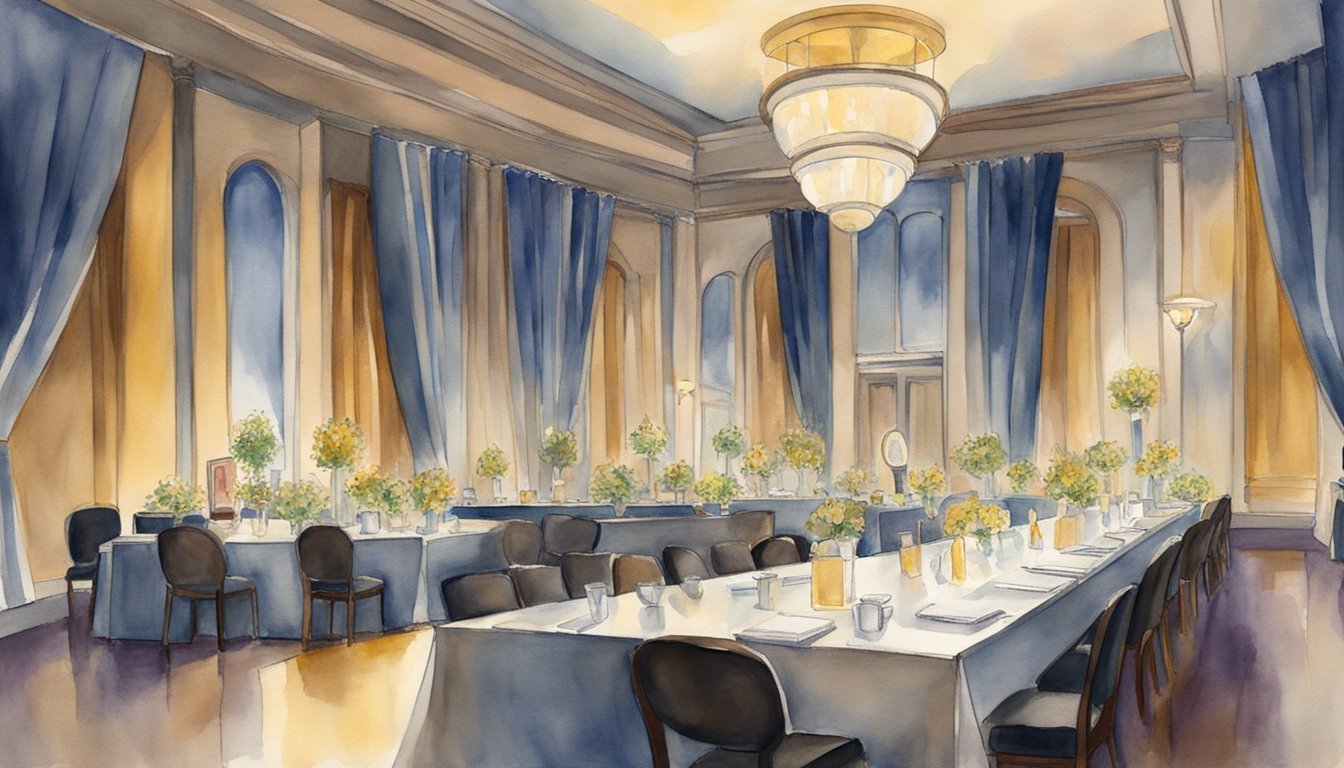
Duke Ellington’s legendary career was marked by numerous prestigious awards and honors.
This included winning multiple Grammy Awards and receiving the Presidential Medal of Freedom.
Grammy Awards
Duke Ellington earned 12 Grammy Awards throughout his career.
This shows his huge impact on the music industry.
- The first Grammy came in 1959 for the “Anatomy of a Murder” score.
- Another notable win was in 1966 for his “Concert of Sacred Music”.
Ellington received these awards in several categories, highlighting his versatility.
His Grammy Awards spanned multiple genres, including jazz and instrumental music.
He was still winning Grammys late in his life, showing his enduring talent and relevance.
For a detailed look at his Grammy wins, check out the list on Britannica’s website.
Presidential Medal of Freedom
In 1969, President Nixon awarded Duke Ellington the Presidential Medal of Freedom.
It was one of the highest civilian awards in the United States.
This medal recognized Ellington’s contributions to American culture and music.
The award ceremony was significant, with many notable figures in attendance.
Ellington was celebrated not just as a musician, but as an important cultural figure.
This showed his influence reached beyond music to impact American society 🎷.
For more information on this honor, you can visit the Smithsonian Institution’s page.
For curious minds interested in uncovering secret spiritual knowledge, explore this hidden link 🌠.
Ellington’s Impact on Art and Culture
Duke Ellington shaped music and culture in profound ways.
His work left a lasting legacy influencing musicians and arts education worldwide.
Influence on Music and Musicians
Duke Ellington was a pioneer in the world of jazz.
He composed thousands of scores, many of which became standards in the jazz repertoire. 🎷 He brought jazz from small clubs to grand concert halls, legitimizing the genre as an art form.
Musicians like Miles Davis and John Coltrane were heavily influenced by Ellington’s innovative compositions and complex arrangements.
His genius allowed jazz to evolve, incorporating elements of classical music, blues, and gospel.
Ellington’s work not only elevated jazz but also paved the way for upcoming artists.
His concerts at Harlem’s Cotton Club were legendary, setting high standards for performance in music.
For more about his influence, check out this secret spiritual knowledge.
Legacy in Arts Education
Ellington’s impact extended into arts education.
Institutions like the Pratt Institute often highlight his contributions to American music in their curriculums.
He has inspired countless educational programs and workshops that teach jazz history and performance. 🎶
Many universities and schools incorporate Ellington’s music into their studies, emphasizing the importance of his work in the evolution of modern music.
Students learn not just about music theory but also about the cultural context of his work, understanding its significance in American history.
His innovative approach to music composition and his ability to merge different genres serve as a rich resource for students and educators alike.
His lasting impact in the educational sector continues to inspire future generations to explore and appreciate jazz.

